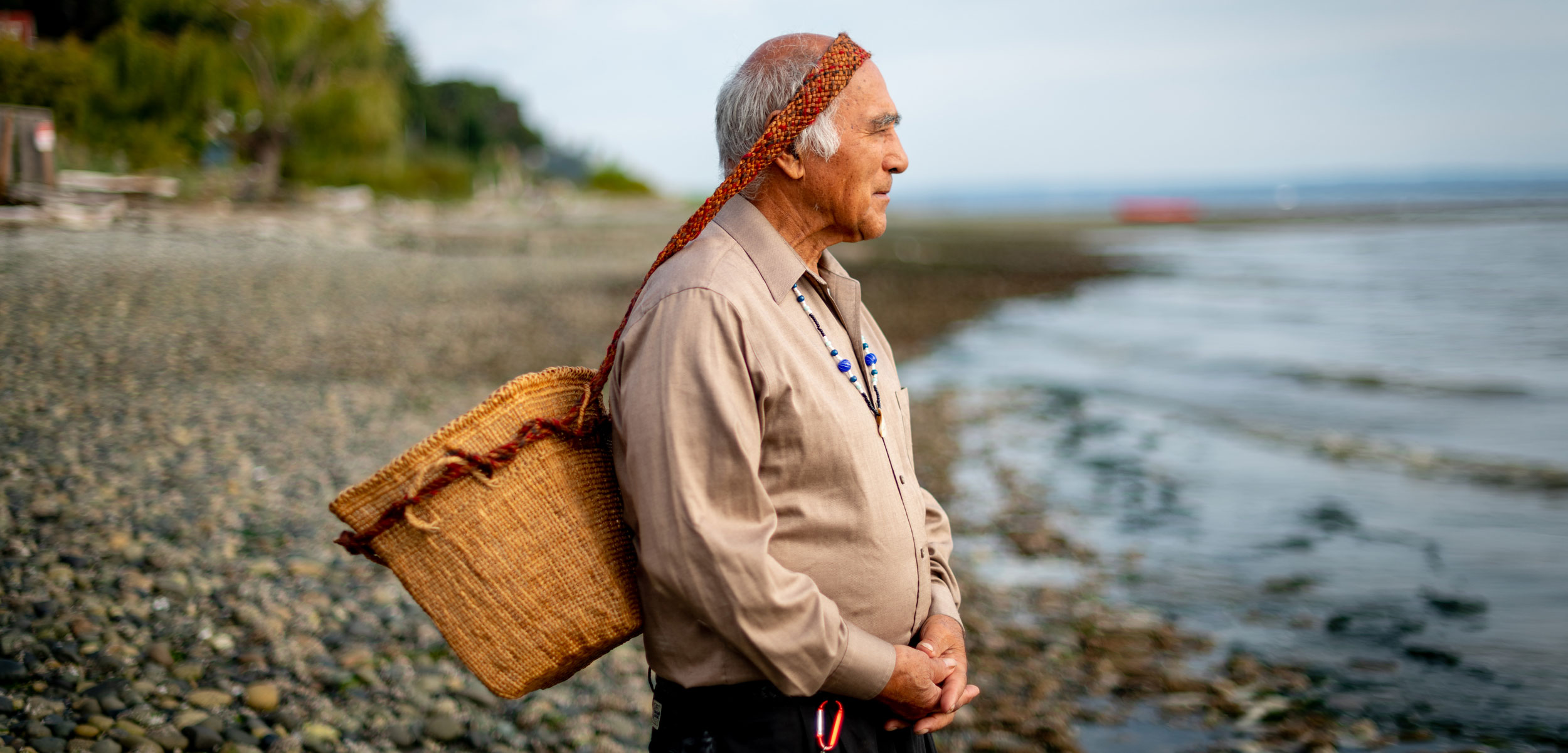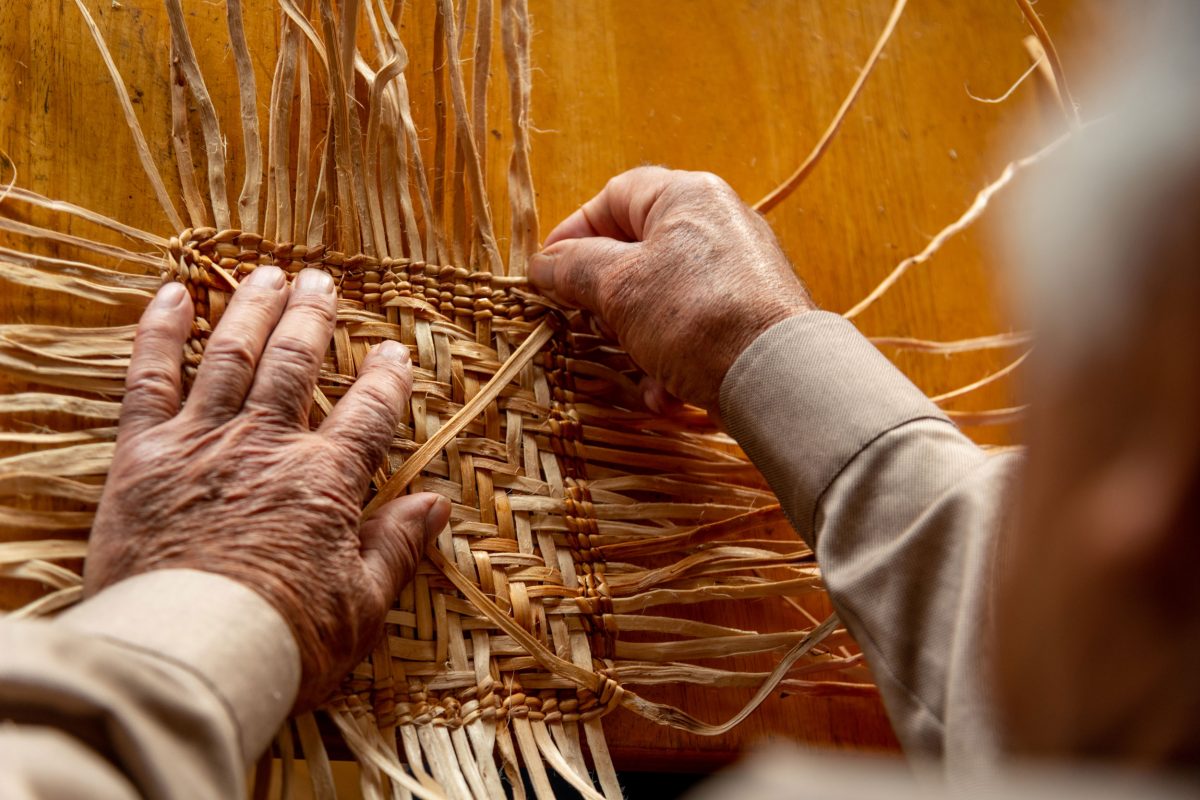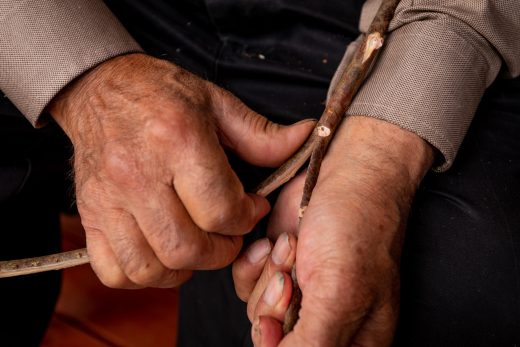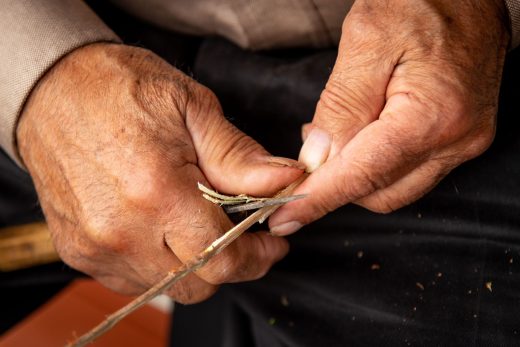The Basketmaker
Through the practice and poetry of basketmaking, lives, cultures, and generations intertwine.
Article body copy
Part One
The Gathering
Along a path hemmed by sword ferns and salal bushes, Ed Carriere leads me to a felled red cedar log in a forest. Rotting chunks of wood, broken off the log, stain the earth a deep ocher color. This is the perfect place for us—me and archaeologist Dale Croes—to collect roots for weaving my first basket. As one of the world’s last Suquamish basketmakers, Carriere is going to show us how.
Red wood and dirt flying, he breaks apart the log with a garden claw. New cedar roots underneath draw nutrients from the log, the basketmaker explains. A root tipped with a single salal leaf, however, emerges first from the damp forest floor. Carriere holds the root in his meaty hands—hands that have woven over 600 baskets, hands that dynamited apart a granite boulder to build a stone fireplace, hands that carved a canoe from a gigantic cedar, and fought an elephant seal off that canoe when the seal attacked it—those hands gently toss the salal root aside. No good, he mutters, they only break apart when you try to weave them. He returns to hacking the log.
Basketmaking is one of the oldest arts in modern human history, cropping up in nearly every culture. By coiling, plaiting, and weaving natural fibers—creating baskets—humans in the past also recorded details of our shared history, the plants and animals we lived among, the food we ate, and the events that marked a life.
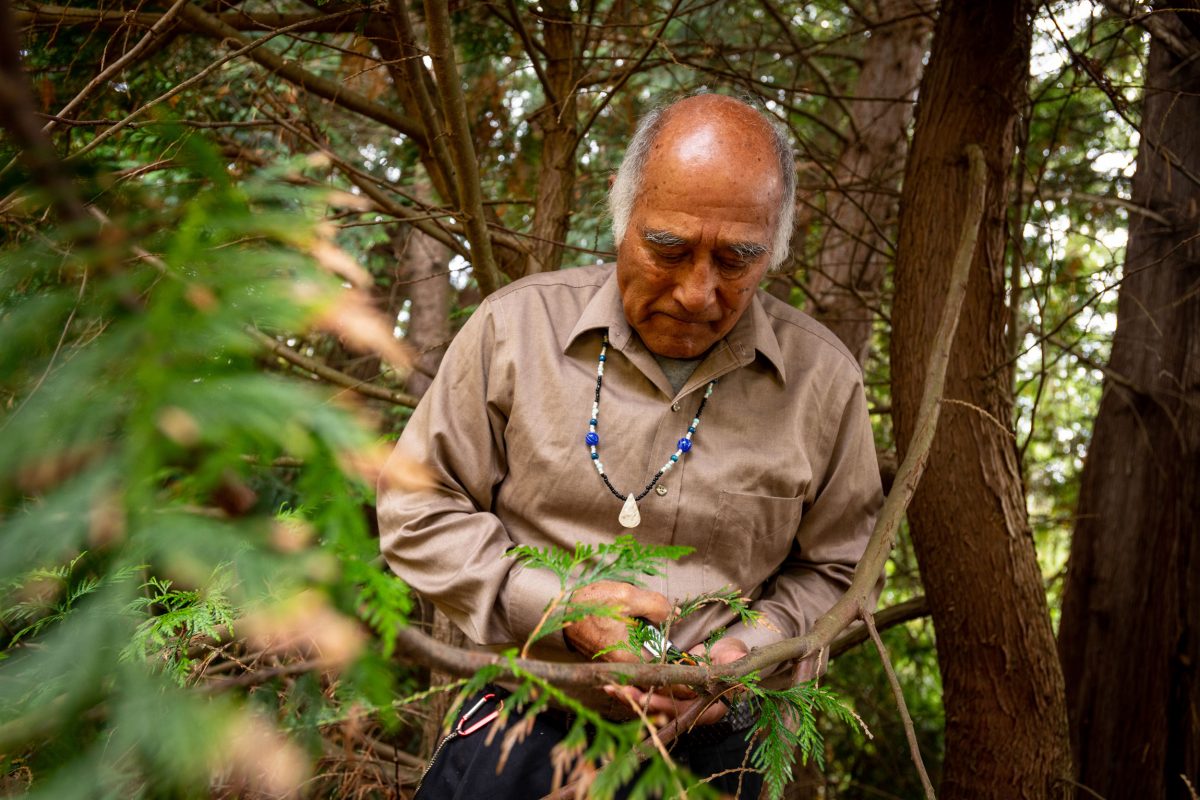
Carriere combs the forest on his property, which he has spent decades cultivating to ensure a steady supply of basket-weaving materials. Photo by Stuart Isett
Archaeologically, however, baskets are the rarer artifact compared with pottery and stone tools, because they’re delicate and more prone to decay. Along the Pacific Northwest coast, where Carriere lives outside Seattle, Washington, floods and construction occasionally unearth ancient baskets that look strikingly like his own. Whenever Carriere has the chance, he visits these rescue excavations with Croes, a now-retired Washington State University (WSU) archaeologist. About 15 years ago, the two began a collaboration, replicating ancient baskets and using the originals as portals to the time of Carriere’s ancestors.
Practicing the craft of his distant relatives, Carriere can feel their hands on his, helping him pull roots from the soil as they did thousands of years earlier, just as he’s doing right now in the forests of Puget Sound. When you’re one of the few master Suquamish basketmakers left in the world, the past has a lot to teach you.
Part Two
Preparation
In 1948, Ed Carriere wove his first clam-gathering basket by watching his great-grandmother, Julia Jacobs. She, too, was one of a few Suquamish basketmakers. Carriere called her kia’h (grandmother in Lushootseed, a Coast Salish language shared by Indigenous peoples from British Columbia to Washington). She raised him on the property where he still lives, overlooking Puget Sound in Indianola. On a clear day, Seattle’s skyscrapers gleam in the distance.
As a young boy, Carriere learned by watching his kia’h as she gathered young boughs, about the thickness of her thumb, from the drooping lower reaches of the western red cedar. Why did she choose this branch and not another? Why that thickness or that length? He knew not to ask his kia’h questions. Just watch and learn. That’s the Suquamish custom and how Jacobs learned from her mother, growing up in Old Man House—the largest longhouse in the Pacific Northwest—a 20-kilometer paddle across the sound to Seattle. Decades later, his kia’h is gone, but Carriere is still learning to weave by observing the work of long-gone elders, whose artistry remains, preserved in the muck of the shoreline.
This past summer, the digging of a sewer line in British Columbia, 150 kilometers north of Carriere’s home and 30 kilometers south of Vancouver, exposed 50 ancient baskets. Together Carriere and Croes traveled across the Canadian border to examine the site and encountered a familiar friend: a large conical basket with two handles. Possibly used to store and carry food, this basket crops up in different styles across numerous tribes and nations in the region, and is tangible evidence of a shared culture between Coast Salish peoples of Washington and British Columbia.
One of the ways ancient baskets survive is in what archaeologists call a wet site, where groundwater constantly saturates and preserves organic matter, by sealing out oxygen and the decaying effects of bacteria and fungi. (Dry or frozen environments also preserve baskets, leading to discoveries in the deserts of Egypt and the highest mountains of Washington and British Columbia.) There are thousands of wet sites still out there in the Pacific Northwest, some known, some unknown, most still waiting to be excavated. West Coast archaeologists tend to balk at the prospect, quoting a lack of time, money, or expertise. Wet sites also have their own soggy nature to thank for eluding detection. Archaeologist Quentin Mackie, from the University of Victoria (UVic) in British Columbia, points out that developers are less likely to build in bogs, marshes, or intertidal areas, so wet sites are less likely to be discovered and examined.

Clam gathering baskets were an essential tool for people, like the Coast Salish, living along the shoreline. Photo by Stuart Isett
Instead, artifacts like stones, bones, and broken shells usually hog archaeologists’ attention—things found in shell middens. Croes believes this is a missed opportunity to create a more complete picture of how an ancient world operated. Neglecting wet sites and the basketry contained inside also overlooks the lives of women, who were predominantly the weavers of ancient times. Wet sites have 90 percent of the material culture, a diversity of artifacts rarely found in midden sites, Croes says. “You just have to find the waterlogged portion.”
The oldest fiber found so far in the Pacific Northwest is in the islands of Haida Gwaii, British Columbia, and dates back 10,700 years. As more discoveries along the west coast of the Americas reveal that early humans may have peopled the continent by following and surviving along the coastline, wet sites uncover intimate details about how they fished, hunted, ate, and lived. And baskets are an integral part of the puzzle.
By weaving, early humans could catch more fish; gather more berries; boil, dry, and store more food; furnish homes; and cover bodies. Like the invention of fire, baskets belong to humanity. The endless variety of baskets—from Scottish oak tatty baskets to Indonesian bamboo and rattan fishing traps to twined grass grain bags from Egypt—testify to all the landscapes in which humans found themselves surviving. The basket played a role in the birth of civilization, carrying the fruits of our labor as hunters and gatherers and later as farmers and merchants. Creation myths from Mesopotamia to Mali paint our debt to the humble basket with Babylonian gods and first ancestors forging the world with a basket. Ironically, baskets helped us create a world where we no longer need to weave them ourselves.
And yet, baskets have a persistent popularity today: as fragile fiber pressed into sodden soil, as art object, as a link between Indigenous peoples and their ancestors, and on the YouTube Primitive Technology channel, where millions watch silent videos of a palm leaf basket under construction. With all the easier and available storage options out there, we still choose to decorate with woven rattan baskets from Ikea. “The world is truly riddled with baskets,” writes Willeke Wendrich in The World According to Basketry. “Once you have lost your innocence, you cannot stop noticing them.”
Part Three
Warp: the basket’s stiffer supporting strands around which the more flexible strands are woven.
From the blinding white sky above, a light rain falls and I can almost hear the forest—the basketmaker’s forest—sigh in relief. This past summer, Carriere turned 84 and forest fires raged across western Canada and the United States. Hundreds of forests burning at once, filling the sky with smoke, blotting out the sun, and hurling fire tornadoes into the heavens.
Carriere’s 32 hectares (close to the size of Disneyland) were spared. Gripping cedar roots in his left hand, trailing their long tails behind him, the basketmaker returns to his white jeep parked on a rutted path in the forest. Along the way, he kicks another log (“humph, hemlock”) and surveys a pile of deciduous cuttings lumped on a wall of blackberry bushes. “Someone’s been dumping stuff here,” he says, mostly to himself. “Gotta keep an eye on that.”
His whole life, he’s managed this land, staggering the planting of California redwoods and western red cedars to create a multi-aged forest that provides the best basketry materials possible. Recently, he was trimming a path through some 3,500 cedars he had planted 12 years earlier, when he noticed that the cedars’ lower boughs were ready to weave. These adolescent branches create the stiff frame, the warps, of the Suquamish clam basket. For the flexible horizontal weave of the basket (the wefts), young roots are best, such as those growing from the ancient crumbling log Carriere led me to, garden claw in hand.
One of the biggest challenges facing basketmakers today is access to material. “Where can you go in the city to strip cedar trees? Or gather cherry bark? Or put your cherry bark in the iron-rich soil and turn it black?” asks Susan Rowley, the University of British Columbia’s Museum of Anthropology curator. “There’s all these processes that you need to do before you even start to create the basket.”
Back in the jeep, Carriere slowly pilots Croes and me back down the road to his home, where we’ll spend the day weaving. On the way, we pass a baseball field that Carriere leased to a local youth sports association for a dollar. Nearby is a nonprofit native horsemanship camp (again, Carriere’s land leased on the cheap).
Inside his living room-cum-workshop, we set to work. “I’m going to skin some of your roots, Ed,” Croes says, about the roots we pulled from the log. “That sounds good,” Carriere replies absently, already absorbed in cutting offshoots and twigs from the cedar boughs.
As Croes whittles, he points to the pile of bark shavings, a deep cherry color, building on the floor—aside from the baskets themselves, wet sites preserve basketmaking debris. “That’s what we find archaeologically,” he says.
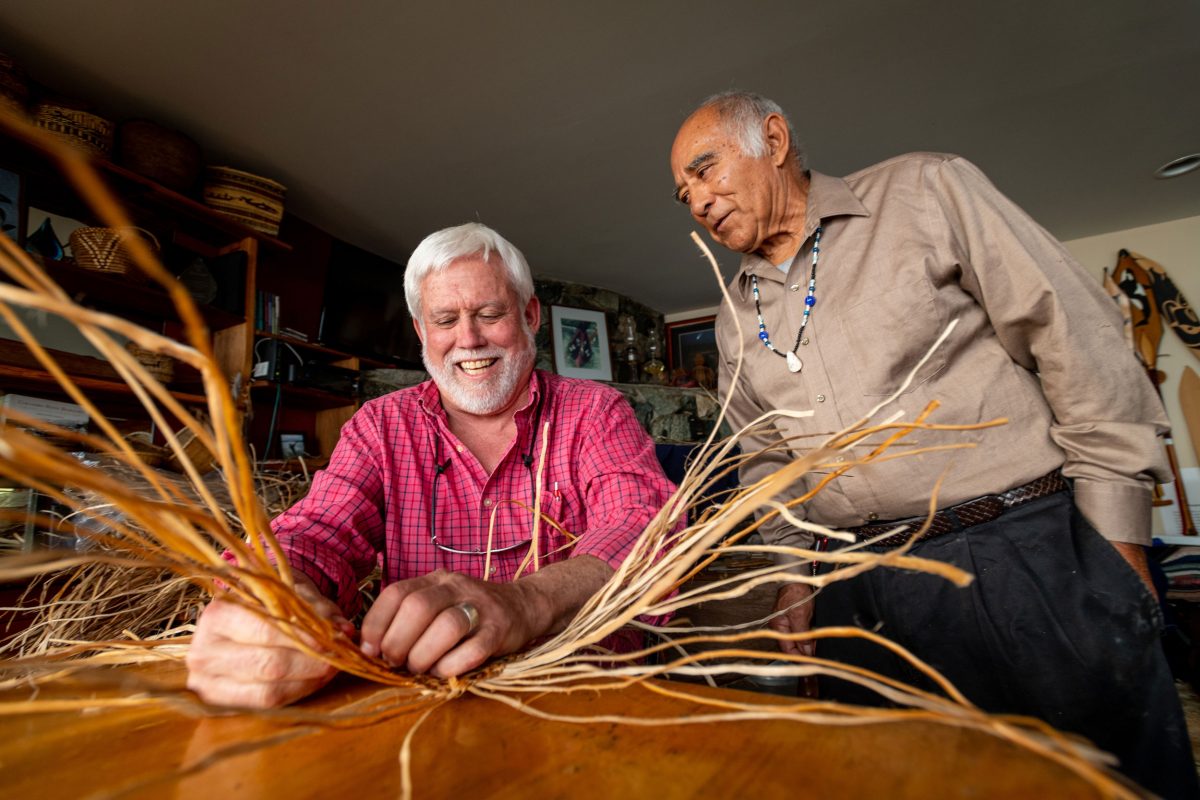
Archaeologist Dale Croes, left, has been collaborating with Carriere, right, to replicate 2,000-year-old baskets found during an excavation along the Snoqualmie River near Seattle, Washington. Photo by Stuart Isett
In 2005, Croes invited Carriere to his first wet site excavation in Squaxin territory at the southern corner of Puget Sound. Croes and his team of archaeology students were uncovering 400- to 700-year-old clam gathering baskets that were so perfectly preserved, so like the ones that Carriere wove himself, that he half-believed Croes had planted them. Ever since, they’ve been sharing knowledge about how early North Americans wove baskets.
When one master’s student at the site turned up stone blades hundreds of years old, Carriere tested whether they were tools for making baskets. The stones could still split cedar so well that Carriere enjoyed working with them. From there, Croes and his team looked closer to confirm how the weavers used the stones. “[We] look microscopically at the ancient ones to see if the damage from carving the baskets is similar to what [Carriere] creates,” Croes explains. “They’re identical so you know the use-wear is the same. They’re using them to carve basketry.”
Using a knife, Carriere shows me how to trim twigs from the cedar bough with one fluid and flourishing upward stroke. On my first try, the knife slips and I shave off a strip of bark as long as a golf tee. I look guiltily to Carriere for reassurance. “That’s okay,” he says quietly, taking the knife away and demonstrating the stroke again.
A master basketmaker splitting a cedar branch is truly something sublime. First, he wedges his dull knife into the thick end of the branch. Then, he lays the branch along the blue arterial veins of his right arm and slowly pulls the stick into equal parts using both hands, releasing the spicy smell of cedar sap into the room.
Using a knife he fashioned from the blade of a buzz saw, Carriere strips and splits a cedar limb for basket-weaving. Photos by Stuart Isett
A decade after the dig in Squaxin, another project truly wove Carriere’s cultural and Croes’s archaeological knowledge together. Around 40 kilometers inland from Carriere’s home is the first and one of the largest wet site discoveries in the Pacific Northwest: the Biderbost site on the Snoqualmie River. In 1959, a historic flood exposed the riverbed, revealing 2,000-year-old baskets, woven mats, and other tools. At the time, very little was known about how to preserve ancient fibers found at wet sites. But now Croes is bringing Carriere’s knowledge and new technology to the artifacts.
By replicating the baskets found there, Carriere realized that the ancient masters had a lot to show him. For instance, basket handles: Carriere typically wove a handle at the rim, but these ancient weavers placed it farther down the basket’s body. “I thought, well, you wouldn’t put the handles down below the rim, but then once I did it, I said, why that’s the only place to put the handles.” In this superior position, the handles strained on the whole basket, rather than just the rim, and the basket lasted longer.
One of Croes’s collaborators, Kathleen Hawes, analyzed the Snoqualmie basket weave microscopically and identified which part of the cedar was being used: bark, bough, or root. After a lifetime handling these materials, Carriere finally had the chance to peer inside the fiber itself. The images astonished him. At this minute level, the cedar limbs form a web of interlocking growth rings. “All these beautiful little … ” Carriere says, searching for the right word to describe the pattern. “Just like a basket,” he finishes.
Part Four
Weft: the basket’s more flexible material which the weaver wraps around the stiffer supporting warps.
Hours pass and we are still cutting and splitting and skinning wood. Carriere, I realize, might be a perfectionist. He hasn’t sat down all afternoon. Wood shavings cover his pants and his black kittens weaving around our feet. His tea is cold. A mat of green cedar needles carpets the floor. When I try to tidy up, he says to leave them be, he’ll sweep them into his stone fireplace later.
For all this woodworking, I’m surprised at the lack of splinters. Cedar split into even and smooth strips leaves no splinters, Carriere says, and he holds his hands out to show me. For someone who has twisted wood splints over half his life, Carriere has unexpectedly smooth hands. When a root does dry out, he restores its flex by running it through a metal bowl of water on the worktable. Or he swirls his neglected cup of tea with a twig. “That’s if you want a cedar tincture,” he laughs dryly.
A single basket can take hundreds of hours to make, from collecting to preparing to weaving, not to mention the thousands of hours a weaver has spent training. In the old days, there were likely a couple of Suquamish weavers who supplied the tribe with thousands of baskets throughout their lives, Carriere reckons. Born in the 1930s, he grew up in the waning hours of this tradition.
After he completed that first rough cedar basket at age 14, Carriere used it to collect clams with his uncle and cousins. The Suquamish clam basket is perfect for this. The square basket allows the ocean in through an open weave, washing sand from the clams. As the tides recede, hundreds of butter and steamer clams reveal their hiding places with tiny holes scattered across the sand. They dug for them and sold them for six cents a pound in the city—more if they shucked and jarred them themselves.
One night, Carriere and his uncle went to a beach on Bainbridge Island even though they knew the white people didn’t like them clamming there. As they gathered by lamplight, a man yelled at them from nearby Agate Pass Bridge and fired a gun. But he was too far away and the bullets lost speed, falling harmlessly around them. For his great-grandmother, the prejudice cut both ways. As a black woman adopted into the tribe as an orphaned baby, she lacked the Suquamish look and the official Suquamish status. And yet, she accumulated deep reserves of ancestral knowledge. By the 1940s, she was one of the only basketmakers left, still splitting cedar boughs and weaving roots by coal oil lamp until her hands gave out.
By the time Carriere entered North Kitsap High School, his first basket was about ready to fall apart. And there were new, cheap wire baskets for sale. “Oh, we don’t want those cedar limb clam baskets,” Carriere remembers his uncle saying, “we want these wire baskets, they’re much better.”
Although his kia’h never commented on his clam basket directly, he knew that she was pleased. Another Suquamish tradition is that no one can force children to weave: they must feel the urge on their own. Jacobs’s adopted mother felt the urge, and so did Jacobs. And then the urge skipped two generations and Carriere came along and he felt it, too. Baskets are woven just like they’re passed down from generation to generation: each strand supports the next in line until a fabric, and eventually a basket, takes shape. For Suquamish basketry to survive, it needed that next generation to take up the strand and weave.
Part Five
Twining: twisting or turning two weft strands together along the stiffer warps.
In 1970, a hiker discovered a 2,000-year-old village preserved in a mudslide near the Makah village of Neah Bay on Washington’s Olympic Peninsula. People compared the find with Pompeii, but in clay. For a time, wet sites were in the news, capturing public and academic attention. Typically, wet site excavations uncover refuse piles near intertidal areas where the people ditched baskets, broken beyond repair. The Ozette village was something else entirely. As a WSU graduate student starting his career, Croes was in professional ecstasy over the find. He spent days moving piles of clay off the six longhouses. Eventually, he recovered 246 ancient baskets, which became a foundational part of his life’s work. Using statistical models and other analyses, he hypothesized that culturally Coast Salish basketry has endured for the last 3,000 years.
The Makah Tribe, however, had a condition for the Ozette village excavation on their territory. They insisted Croes learn to weave baskets with the community’s elders. At first, he resisted the idea. “I didn’t really want to do it. I didn’t think I had to do that to understand the ancient baskets,” he remembers, but “I was really wrong.” For a semester of his graduate degree, Croes weaved with Makah elders in Neah Bay, overlooking the Juan de Fuca Strait. During those months, he saw firsthand how intrinsic baskets are to Makah identity and established a long-running collaboration with the community. Meanwhile, one of his teachers, Isabelle Ides, was also training Ed Carriere.
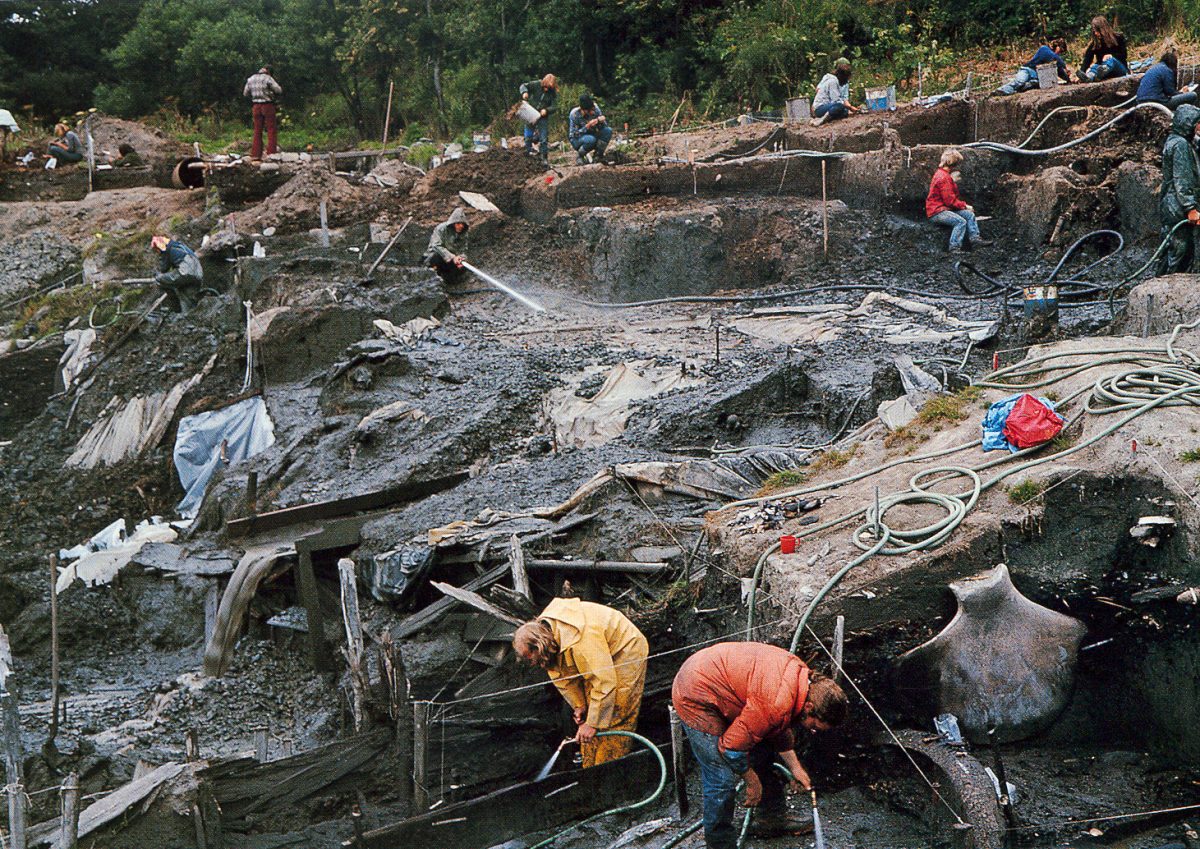
A team of excavators helped uncover the Makah village of Ozette on Washington’s Olympic Peninsula. The painstaking process took years and uncovered dwellings—evidenced by the house walls—and detritus of Makah life, such as whale bones most likely from a hunt. Photo by Ruth Kirk
At the time, in his mid-30s and married with two children, Carriere’s last basket creation was nearly 20 years old. He was realizing that, if he never weaved again, the Suquamish tradition would die with him. For years, he had visited Ides with his kia’h, so Jacobs could catch up with her old friend and fellow basketmaker in Lushootseed, their shared Coast Salish language. After his great-grandmother died in 1962, Carriere continued the visits, collecting spruce roots with Ides along the forest-backed beaches of the Makah reservation. With patience and persistence, along with help from Ides, Carriere found his way back to baskets.
During one visit to Neah Bay, Carriere hiked out to the Ozette site and saw huge holes in the ground, dug by Croes and his team extracting hundreds of baskets. He and Croes have no idea if they crossed paths that day, but their lives continued to intersect and echo one another’s. Both had spent time in the military: Carriere as a marine in the Korean War and Croes in the Army National Guard during the Vietnam War. Both volunteered for the Washington State Centennial celebrations in 1989: Croes organizing a conference in downtown Seattle near to where Carriere paddled in the centennial’s inaugural canoe journey. Both had a lifelong interest in baskets, and unknowingly each shared time with Ides for decades.
In 2000, Ides finally connected them incidentally. At her 100th birthday potlatch, Carriere presented her with a Makah-style burden basket, traditionally used for carrying, made of the spruce roots she had taught him how to collect. Croes watched from the audience, dumbstruck by the masterful basket in Carriere’s hands. At last, their lives intertwined.
Part Six
Locker weave: a transition weave that secures the basket base before beginning the three-dimensional sides.
Finally, we are ready to weave. Carriere’s finessing has transformed cedar boughs and roots into impossibly thin and even strands. Any imperfections Carriere has sliced away with his knife. He lays six smooth pieces, bark side up, across the worktable. He takes three more and interlocks these horizontally with the first six. From this bare beginning, a classic Suquamish clam basket will grow. This petite, but deep basket will have rounded handles, a widely spaced weave, and will hold 200 clams comfortably. To make the base, he slots in more pieces, one by one, finishing with a locker weave that holds the strips in place. Now it’s time to get three-dimensional.
As we begin the body of the basket, I expect Carriere to turn the reins over and tell me to get weaving. But he doesn’t. His hands continue to tweak and twist the basket in small unintuitive ways. When he does hand the basket to me, there’s always some complicating factor, like the rounding of a corner or the inserting of a new strand, and I need his help almost immediately, so back the basket goes into his hands.
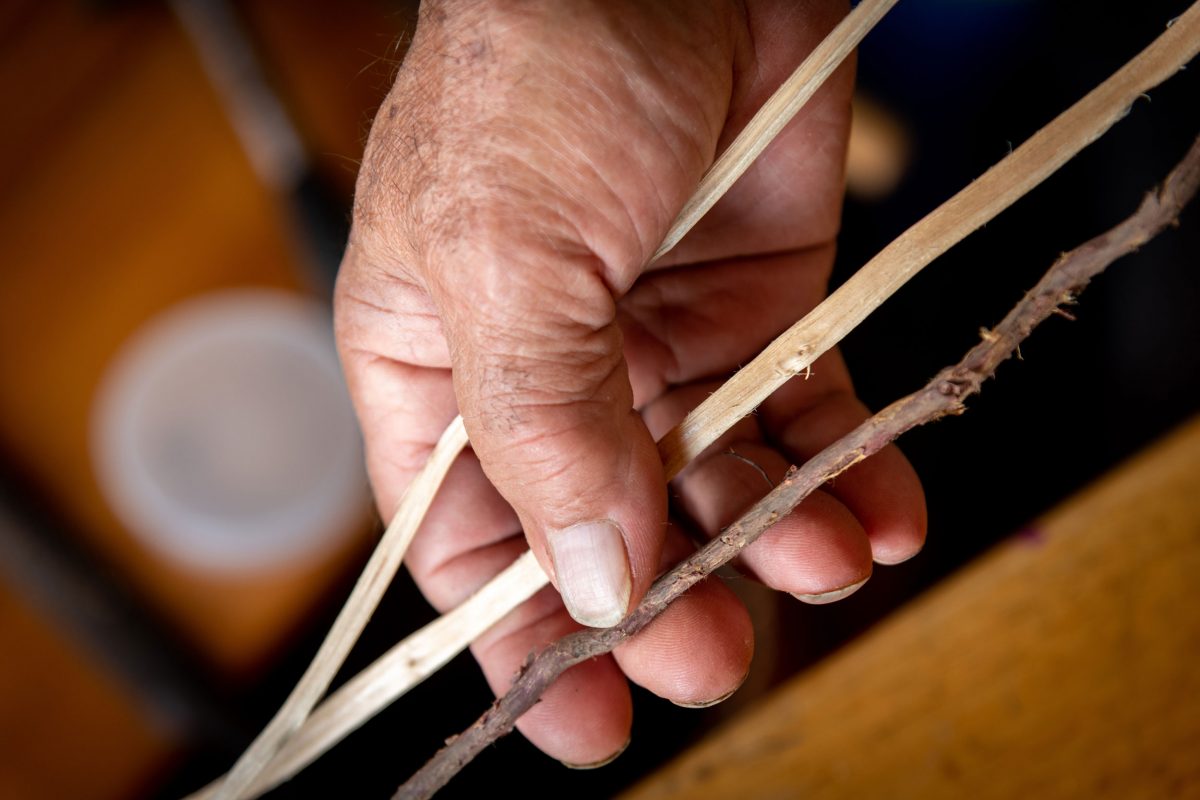
One of the biggest challenges for basketmakers today is accessing the right material, such as flexible roots or young boughs. Photo by Stuart Isett
Pouring so many hours into weaving a basket means that it eventually takes on the personality and even the physicality of its creator. When Carriere checks the measurement of one splint, he holds it against his body: from finger to nose is just shy of a meter, arm to arm is nearing two. He tells me that he can spot his work and his apprentice’s immediately. When his great-grandmother’s baskets surface at antique stores, he knows her weave instantaneously, too. Baskets line the walls of his living room, like a “little museum,” with exhibits from him, his great-grandmother, and other weavers. Before his retirement 30 years earlier, the baskets were for selling and teaching. Nowadays, he takes the occasional commission, but mostly the baskets are experiments, set and doggedly pursued over months and years.
I ask whether he listens to the radio or watches TV while he weaves. Sometimes, he says, but mostly he’s content to sit and weave quietly. “A lot of time I think about how I’m doing it in honor of those old weaving people: making their style of basket, working with the fiber.” His favorite basket to make is the clam basket—the one he’s teaching me and the same one Jacobs taught him all those years ago.
After the media coverage and public interest in the Ozette excavation of the 1960s and ’70s, Croes hoped to see wet sites become a force in Pacific Northwest archaeology. He says that after the work at Ozette, everyone was doing wet sites for a while, but it was the golden age, a fad.
Over the last 15 years, a few discoveries have rekindled interest in wet sites, like the 10,700-year-old Haida Gwaii find and 13,000-year-old human footprints stamped into the shoreline of Calvert Island—both in British Columbia. “The intertidal zone was always something you walked over to get to the real archaeology,” says UVic archaeologist Mackie. “But what we’re finding is that lots of sites with intact cultural remains are in the intertidal.”
This groundswell of interest is also happening overseas, where Croes and Carriere are finding an audience for their work at conferences and workshops. In Japan, they worked with bamboo weavers and the Indigenous peoples, the Ainu. In England, they presented their work at a gathering for international wet site and wetland archaeologists. In 2019, they’ll present a keynote talk at the Experimental Archaeology Conference in Italy. For Carriere, it’s unbelievable that baskets could take him around the world.
Just like the repeating intersections of Croes and Carriere’s lives, history repeats itself in another way. Carriere’s great-grandmother also worked with academics in her time, translating Lushootseed for University of Washington linguists. Croes and Carriere have become collaborators, recently publishing a book, Re-Awakening Ancient Salish Sea Basketry, about their lives and experiments.
Part Seven
Selvedge: the top finished rim of the basket, sometimes with a decorative flourish.
It’s nearly time to catch my train home. Croes has already taken his leave, driving home before the sun sets. Unfortunately, my basket is only a half-finished bowl of cedar strips that I will carry home and figure out on my own. Carriere moves around the living room, collecting roots and coiling them into loops for easy soaking. During our workshop, he explained his process to me step by step, completely unlike how his great-grandmother taught him. I ask whether he’s training his apprentice in this new Western way. Yes, he says. “You can learn both ways, but to learn the Indian way, you have to be there 24 hours a day, seven days a week, watching. And nobody can do that now.”
Perhaps what’s more important for weaving baskets is simply persistence. “That’s what I looked for in Josh Mason,” Carriere says about his apprentice, a member of the nearby Squaxin Island Tribe. “I looked for his ability to have the patience to split these limbs and work with them. And he had it. He was determined that he was going to do it. That he was going to make the basket.”
His ancestors might not recognize the frenzied world around him, but they would recognize the craft Carriere brings to weaving baskets in this house overlooking Puget Sound. Colonization and forced assimilation tried to scrub it out, but Carriere and Coast Salish baskets survived. He’s still here, ripping roots from the ground, trimming boughs from western cedars, and training the next generation to take up the next strand and weave.
With that kind of history behind you, the hours it takes to weave a basket simply fall away. If you’re going to weave a basket—a process of indeterminate time, a process so antithetical to our multitasking world obsessed with traceability and results—you may as well accept that it’s going to take as long as it’s going to take. You may as well accept that you might have to undo a few mistakes and start over. Sooner or later, a basket is born and tells the story of its maker.

